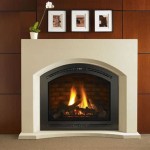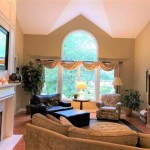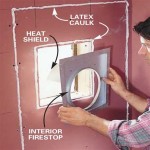Rock Wall Fireplace: A Timeless Element for Home Design
Rock wall fireplaces have long been a focal point in residential architecture, offering a blend of natural aesthetics and warmth. They represent more than just a heating element; they serve as a statement piece, adding texture, depth, and character to any living space. The enduring appeal of rock wall fireplaces stems from their ability to seamlessly integrate with various design styles, from rustic and traditional to contemporary and modern.
The selection of materials, construction methods, and design considerations are essential factors in creating a rock wall fireplace that is both visually appealing and structurally sound. This article will explore the different facets of rock wall fireplaces, delving into the types of rock commonly used, the benefits they offer, and the key elements involved in their design and installation.
Types of Rock Used in Fireplace Construction
The visual character of a rock wall fireplace is largely determined by the type of rock employed. Each type offers unique characteristics in terms of color, texture, and pattern, influencing the overall ambiance of the room. Understanding these differences is crucial for selecting the right material to complement the desired aesthetic.
Fieldstone, a classic choice, consists of naturally rounded stones gathered from fields and streams. Its irregular shapes and varied colors provide a rustic and organic look, ideal for creating a cozy and inviting atmosphere. The installation process often involves meticulous arrangement to achieve a balanced and visually pleasing composition.
Ledgestone, characterized by its thin, flat layers, offers a more refined and contemporary appearance. Its horizontal lines create a sense of linearity and can make a room feel wider. Ledgestone is available in a variety of colors and textures, allowing for versatility in design. It is often used to add a touch of sophistication to modern interiors.
River rock, similar to fieldstone but typically smoother and more uniform, is another popular option. Its rounded shapes and earthy tones evoke a sense of tranquility and connection to nature. River rock is well-suited for creating a serene and relaxing environment. The smooth surface also makes it easier to clean compared to more jagged stone types.
Stacked stone, a manufactured product designed to mimic natural stone, offers a cost-effective and lightweight alternative. It is available in a wide range of colors and styles, providing designers with greater control over the final appearance. Stacked stone is easier to install than natural stone, making it a popular choice for DIY projects and renovations.
In addition to these common types, other options include granite, limestone, and slate, each offering distinct characteristics. Granite provides a sleek and modern look with its smooth surface and varied colors. Limestone offers a softer, more traditional feel with its porous texture and light hues. Slate provides a dramatic and sophisticated appearance with its dark colors and layered structure.
Benefits of a Rock Wall Fireplace
Beyond aesthetic appeal, rock wall fireplaces offer several practical benefits. These include enhanced thermal mass, improved acoustics, and increased property value. Understanding these advantages can further solidify the decision to incorporate a rock wall fireplace into a home design.
Thermal mass is the ability of a material to absorb and store heat. Rock, being a dense material, possesses excellent thermal mass properties. This means that a rock wall fireplace can absorb heat from the fire and slowly release it into the room, providing a more consistent and comfortable temperature. This can reduce reliance on central heating systems and lower energy costs.
The irregular surface of a rock wall can also improve the acoustics of a room. The uneven texture helps to diffuse sound waves, reducing echoes and reverberations. This can create a more pleasant and comfortable listening environment, especially in large, open spaces.
Furthermore, a well-designed and constructed rock wall fireplace can significantly increase the value of a property. It is considered a desirable feature by many homebuyers, adding both aesthetic appeal and functional benefits. A rock wall fireplace can differentiate a home from others on the market and attract potential buyers.
Maintenance of a rock wall fireplace is relatively straightforward. Regular cleaning with a brush and mild detergent can remove dust and soot. Sealing the stone can protect it from stains and moisture damage. With proper care, a rock wall fireplace can maintain its beauty and functionality for many years.
Design and Installation Considerations
The design and installation of a rock wall fireplace require careful planning and execution. Factors to consider include structural support, ventilation, clearances, and aesthetic integration with the surrounding space. Engaging qualified professionals is essential to ensure a safe and successful installation.
Structural integrity is paramount. The weight of the rock wall must be adequately supported by the foundation and framing of the building. A structural engineer can assess the load-bearing capacity of the existing structure and recommend any necessary reinforcements. Failure to address structural concerns can lead to serious safety hazards.
Proper ventilation is crucial for safe and efficient fireplace operation. The chimney or flue must be properly sized and constructed to ensure adequate draft and prevent the buildup of dangerous gases, such as carbon monoxide. Regular inspections and cleaning of the chimney are essential for maintaining safe operation.
Clearances to combustible materials must be maintained to prevent fires. The National Fire Protection Association (NFPA) provides guidelines for minimum clearances around fireplaces. These guidelines specify the distance that combustible materials, such as wood framing and furniture, must be kept from the firebox and chimney.
Aesthetic considerations are equally important. The rock wall should be designed to complement the style and scale of the room. The color, texture, and pattern of the rock should be carefully selected to create the desired ambiance. The size and shape of the fireplace should be proportional to the room's dimensions.
Professional installation is highly recommended. Experienced masons and contractors have the knowledge and skills to ensure that the rock wall is properly constructed and that all safety codes are met. They can also provide valuable advice on design and material selection. While DIY projects may seem appealing, the complexity and potential hazards of fireplace installation make professional assistance a wise investment.
The design process should also consider the type of fireplace insert. Options include wood-burning fireplaces, gas fireplaces, and electric fireplaces. Each type has its own advantages and disadvantages in terms of aesthetics, efficiency, and environmental impact. The choice should be based on personal preferences and practical considerations.
Lighting plays a crucial role in accentuating the texture and beauty of a rock wall fireplace. Strategically placed spotlights or recessed lighting can highlight the natural variations in the stone and create a dramatic effect. The lighting should be designed to enhance the fireplace's visual appeal without creating glare or overpowering the room.
Finally, the surrounding décor should be carefully considered to create a cohesive and harmonious space. Furniture, artwork, and accessories should complement the style and color palette of the rock wall fireplace. A well-coordinated design will create a welcoming and inviting atmosphere.
In conclusion, a rock wall fireplace is a significant architectural feature that can enhance the beauty, warmth, and value of a home. Careful planning, material selection, and professional installation are essential for creating a fireplace that is both visually stunning and structurally sound. By considering the various factors discussed in this article, homeowners can create a rock wall fireplace that will be enjoyed for generations to come.

Before And After Ave F House Redondo Beach Stone Fireplace Makeover Painted Rock Fireplaces

65 Best Stone Fireplace Design Ideas To Ignite Your Decor Modern Designs

Natural Stacked Stone Veneer Fireplace Ideas

Fake Rock Wall Panels For Stone Fireplace

20 Fabulous Rock Wall Living Room Ideas To Amaze Your Guest Contemporary Fireplace Modern Stone Livingroom Layout

60 River Rock Stone Molds Make 1000s Fireplace Wall Veneer Free

Add River Rock To Your List Of Fireplace Design Ideas You Ll Be Glad Did Stone Selexstone Selex
:strip_icc()/Screenshot2021-10-19at09-16-46Portfolio-AmyBartlamPhotography-1f35ea9ec29846779a2d62b42676eff9.png?strip=all)
20 Best Stone Fireplace Ideas

I Can T Stand My Ugly Stone Fireplace What Do Laurel Home

Natural Stacked Stone Veneer Fireplace Ideas
Related Posts








